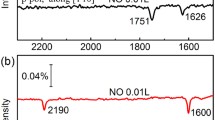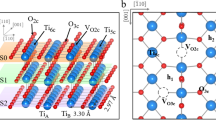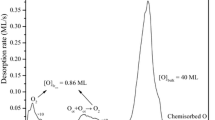Abstract
We present a STM/XPS/TPD/LEED study of the structural and electronic properties of Mo+Ti mixed oxide layers on TiO2(110), and of their interaction with water, methanol and ethanol. Several different preparation procedures were tested and layers with different degrees of Mo/Ti mixing were prepared. Ordered mixed oxide surface phases with distinct LEED patterns could not be found; for all investigated Mo concentrations a TiO2(110) like pattern was observed. Mo tends to agglomerate on the surface where it is found predominantly as Mo6+ at low coverages and as Mo4+ at high coverages. Mo4+ was also identified in the bulk of the mixed oxide layer. The Mo3d binding energies categorize the Mo4+ species as being dimeric. A third Mo3d doublet is attributed to a Mo species (Mon+) with an oxidation state between those reported for Mo in MoO2 and metallic Mo. Two types of Mo-induced features could be identified in the STM images for low Mo concentrations (in the range of 1 %). At higher Mo concentrations (~50 %) the surface is characterized by stripes with limited lengths in [001] direction. The concentration of bridging oxygen vacancies, which are common defects on TiO2(110), is reduced significantly even at low Mo concentrations. Methanol and ethanol TPD spectra reflect this effect by a decrease of the intensity of the features related to these surface defects. At elevated MoO x coverages, the yield of reaction products in methanol and ethanol TPD spectra are somewhat smaller than those found for clean TiO2(110) and the reactions occur at lower temperature.















Similar content being viewed by others
References
Pajonk GM (2000) Contribution of spillover effects to heterogeneous catalysis. Appl Catal A 202(2):157–169
Weng LT, Delmon B (1992) Phase cooperation and remote-control effects in selective oxidation catalysts. Appl Catal A 81(2):141–213
Grasselli RK, Burrington JD, Buttrey DJ, DeSanto P, Lugmair CG, Volpe AF, Weingand T (2003) Multifunctionality of active centers in (amm)oxidation catalysts: from Bi-Mo-O-x to Mo-V-Nb-(Te, Sb)-O-x. Top Catal 23(1–4):5–22
Ferroni M, Guidi V, Martinelli G, Roncarati G, Comini E, Sberveglieri G, Vomiero A, Mea GD (2002) Coalescence inhibition in nanosized titania films and related effects on chemoresistive properties towards ethanol. J Vac Sci Technol B 20(2):523–530
Kim HY, Lee HM, Pala RGS, Shapovalov V, Metiu H (2008) CO oxidation by rutile TiO2(110) doped with V, W, Cr, Mo, and Mn. J Phys Chem C 112(32):12398–12408
Garcia-Mota M, Vojvodic A, Metiu H, Man IC, Su HY, Rossmeisl J, Norskov JK (2011) Tailoring the activity for oxygen evolution electrocatalysis on rutile TiO2(110) by transition-metal substitution. ChemCatChem 3(10):1607–1611
Kim HY, Lee HM, Pala RGS, Metiu H (2009) Oxidative dehydrogenation of methanol to formaldehyde by isolated vanadium, molybdenum, and chromium oxide clusters supported on rutile TiO2(110). J Phys Chem C 113(36):16083–16093
Krüger P, Petukhov M, Domenichini B, Bourgeois S (2009) Molybdenum thin film growth on a TiO2(110) substrate. J Mol Struct Theochem 903(1–3):67–72
Asaduzzaman A, Krüger P (2007) Adsorption and diffusion of a molybdenum atom on the TiO2(110) surface: a first-principles study. Phys Rev B 76(11):115412
Lyubinetsky I, Yu ZQ, Wang CM, Du Y, Thevuthasan S (2008) Reproducible tip fabrication and cleaning for UHVSTM. Ultramicroscopy 108(9):873–877
Horcas I, Fernandez R, Gomez-Rodriguez JM, Colchero J, Gomez-Herrero J, Baro AM (2007) WSXM: A software for scanning probe microscopy and a tool for nanotechnology. Rev Sci Instrum 78:013705
McCarty KF (2003) Growth regimes of the oxygen-deficient TiO2(110) surface exposed to oxygen. Surf Sci 543(1–3):185–206
Li M, Hebenstreit W, Gross L, Diebold U, Henderson MA, Jennison DR, Schultz PA, Sears MP (1999) Oxygen-induced restructuring of the TiO2(110) surface: a comprehensive study. Surf Sci 437(1–2):173–190
Li M, Hebenstreit W, Diebold U, Tyryshkin AM, Bowman MK, Dunham GG, Henderson MA (2000) The influence of the bulk reduction state on the surface structure and morphology of rutile TiO2(110) single crystals. J Phys Chem B 104(20):4944–4950
Jacob KT, Shekhar C, Waseday Y (2008) Thermodynamic properties and phase diagram for the system MoO2–TiO2. J Am Ceram Soc 91(2):563–568
Domenichini B, Flank AM, Lagarde P, Bourgeois S (2004) Interfacial reaction between deposited molybdenum and TiO2(110) surface: role of the substrate bulk stoichiometry. Surf Sci 560(1–3):63–78
Brox B, Olefjord I (1988) ESCA Studies of MoO2 and MoO3. Surf Interface Anal 13(1):3–6
Werfel F, Minni E (1983) Photoemission-study of the electronic-structure of Mo and Mo oxides. J Phys C 16(31):6091–6100
Scanlon DO, Watson GW, Payne DJ, Atkinson GR, Egdell RG, Law DSL (2010) Theoretical and experimental study of the electronic structures of MoO3 and MoO2. J Phys Chem C 114(10):4636–4645
Guimond S (2009) Vanadium and molybdenum oxide thin films on Au(111): growth and surface characterization. Humboldt Universität zu Berlin, Berlin
Wendt S, Schaub R, Matthiesen J et al (2005) Oxygen vacancies on TiO2(110) and their interaction with H2O and O2: a combined high-resolution STM and DFT study. Surf Sci 598(1–3):226–245
Chun WJ, Asakura K, Iwasawa Y (1998) Polarization-dependent total-reflection fluorescence XAFS study of Mo oxides on a rutile TiO2(110) single crystal surface. J Phys Chem B 102(45):9006–9014
Shannon RD (1976) Revised effective ionic-radii and systematic studies of interatomic distances in halides and chalcogenides. Acta Crystallogr A 32:751–767
Henderson MA (1995) Mechanism for the bulk-assisted reoxidation of ion sputtered TiO2 surfaces: diffusion of oxygen to the surface or titanium to the bulk? Surf Sci 343(1–2):L1156–L1160
Li M, Hebenstreit W, Diebold U (1998) Oxygen-induced restructuring of the rutile TiO2(110)(1×1) surface. Surf Sci 414(1–2):L951–L956
Bowker M, Bennett R (2009) The role of Ti3+ interstitials in TiO2(110) reduction and oxidation. J Phys Condens Matter 21(47):474224
CasaXPS (2006) Peak fitting in XPS. http://www.casaxps.com/help_manual/manual_updates/peak_fitting_in_xps.pdf
Grünert W, Stakheev AY, Morke W, Feldhaus R, Anders K, Shpiro ES, Minachev KM (1992) Reduction and metathesis activity of MoO3/Al2O3 Catalysts. 1. An Xps investigation of MoO3/Al2O3 catalysts. J Catal 135(1):269–286
Grünert W, Stakheev AY, Feldhaus R, Anders K, Shpiro ES, Minachev KM (1991) Analysis of Mo3d XPS spectra of supported Mo Catalysts: an alternative approach. J Phys Chem 95(3):1323–1328
Chae HK, Klemperer WG, Marquart TA (1993) High-nuclearity oxomolybdenum(V) complexes. Coord Chem Rev 128(1–2):209–224
Villata LS, Feliz MR, Capparelli AL (2000) Photochemical and catalytic properties of dimeric species of molybdenum(V). Coord Chem Rev 196:65–84
Meriaudeau P, Clerjaud B, Che M (1983) An electron-paramagnetic resonance study of Mo5+ pairs in polycrystalline TiO2. J Phys Chem 87(20):3872–3876
Che M, Fichelle G, Meriaude P (1972) Paramagnetic absorption of pentavalent molybdenum in various symmetries of TiO2. Chem Phys Lett 17(1):66–69
Kyi R (1962) Paramagnetic resonance of Mo5+ in TiO2. Phys Rev 128(1):151–153
Meriaudeau P (1980) Paramagnetic-resonance of interstitial Mo5+ in a TiO2 lattice. Chem Phys Lett 72(3):551–553
Valigi M, Gazzoli D, Jacono ML, Minelli G, Porta P (1982) A structural and magnetic study of the MoO x –TiO2 system. Zeitschrift Fur Physikalische Chemie-Wiesbaden 132(1):29–40
Quincy RB, Houalla M, Proctor A, Hercules DM (1990) Distribution of molybdenum oxidation-states in reduced Mo/TiO2 catalysts: correlation with benzene hydrogenation activity. J Phys Chem 94(4):1520–1526
Yamada M, Yasumaru J, Houalla M, Hercules DM (1991) Distribution of molybdenum oxidation-states in reduced Mo/Al2O3 catalysts: correlation with benzene hydrogenation activity. J Phys Chem 95(18):7037–7042
Briand LE, Tkachenko OP, Guraya M, Wachs IE, Grünert W (2004) Methodical aspects in the surface analysis of supported molybdena catalysts. Surf Interface Anal 36(3):238–245
Deng X, Quek SY, Biener MM, Biener J, Kang DH, Schalek R, Kaxiras E, Friend CM (2008) Selective thermal reduction of single-layer MoO3 nanostructures on Au(111). Surf Sci 602(6):1166–1174
Makinson JD, Lee JS, Magner SH, De Angelis RJ, Weins WN, Hieronymus AS (2000) X-ray diffraction signatures of defects in nanocrystalline materials. Adv X-Ray Anal 42(C):407–411
Li Z, Smith RS, Kay BD, Dohnálek Z (2011) Determination of absolute coverages for small aliphatic alcohols on TiO2(110). J Phys Chem C 115(45):22534–22539
Henderson MA (1996) Structural sensitivity in the dissociation of water on TiO2 single-crystal surfaces. Langmuir 12(21):5093–5098
Hugenschmidt MB, Gamble L, Campbell CT (1994) The interaction of H2O with a TiO2(110) surface. Surf Sci 302(3):329–340
Henderson MA (1996) An HREELS and TPD study of water on TiO2(110): the extent of molecular versus dissociative adsorption. Surf Sci 355(1–3):151–166
Henderson M, Otero-Tapia S, Castro M (1999) The chemistry of methanol on the TiO2 (110) surface: the influence of vacancies and coadsorbed species. Faraday Discuss 114:313–329
Farfan-Arribas E, Madix RJ (2003) Different binding sites for methanol dehydrogenation and deoxygenation on stoichiometric and defective TiO2(110) surfaces. Surf Sci 544(2–3):241–260
Redhead P (1962) Thermal desorption of gases. Vacuum 12:203–211
Kim YK, Kay BD, White JM, Dohnálek Z (2007) Alcohol chemistry on rutile TiO2(110): the influence of alkyl substituents on reactivity and selectivity. J Phys Chem C 111(49):18236–18242
Bondarchuk O, Kim YK, White JM, Kim J, Kay BD, Dohnalek Z (2007) Surface chemistry of 2-propanol on TiO2(110): low- and high-temperature dehydration, isotope effects, and influence of local surface structure. J Phys Chem C 111(29):11059–11067
Kim YK, Kay BD, White JM, Dohnálek Z (2008) 2-Propanol dehydration on TiO2(110): the effect of bridge-bonded oxygen vacancy blocking. Surf Sci 602(2):511–516
Acknowledgments
We acknowledge support from the Deutsche Forschungsgemeinschaft (DFG) through SFB546 (Structure, Dynamics and Reactivity of Transition Metal Oxide Aggregates). Daniel Göbke, Mathias Naschitzki, and Elena Primorac are acknowledged for their support during a beamtime at the BESSY II electron storage ring.
Author information
Authors and Affiliations
Corresponding author
Rights and permissions
About this article
Cite this article
Karslıoğlu, O., Song, X., Kuhlenbeck, H. et al. Mo+TiO2(110) Mixed Oxide Layer: Structure and Reactivity. Top Catal 56, 1389–1403 (2013). https://doi.org/10.1007/s11244-013-0142-y
Published:
Issue Date:
DOI: https://doi.org/10.1007/s11244-013-0142-y




